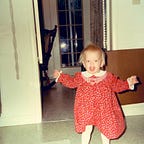Capturing Time
I love going to art museums. When I’m away from home in a new city and looking for something to do, I’ll probably try to find an art museum to go to. I’m not “into” art like some people are and I couldn’t tell you a thing about art history, movements, genres or whatever stuff like that is called.
I love walking around in a quiet building, looking at paintings and trying to feel something, trying to understand, and admiring inspiration made manifest. I appreciate creation, completion, and time.
I recently went on a solo trip to Baltimore for a union caucus thing. It was one of the first few times I’ve been gone overnight away from my boys since they were born over two years ago. When I had a few hours of my own, I went to the museum in the city, part of the practice of gaining back little pieces of me from before kids, if that’s even possible.
Art also makes me sad. It’s difficult to explain exactly what I mean by this. When I look at something like a painting, I feel empty in comparison. I see a moment, a feeling captured, and what I see is time. Time spent and time gone and attempts to perfectly encapsulate something that cannot ever really be depicted. Since I’ve become a parent I have grown an even more palpable appreciation for time. You see your children change from moment to moment and you understand how precious and tenuous everything in life is. When I see pictures of them from when they were smaller, I don’t remember being tired or maybe feeling resentful because I wanted to go see a movie with a friend or something like that, I feel that moment in their lives and me as their personal witness to life. I feel the little specs of the warmth of that present. I see that in art as well so I feel sad and appreciative in equal bits, just like I do as a parent.
The Baltimore art museum had a Richard Yarde special exhibit when I went — these beautiful paintings of movement and negative space. One that I was especially drawn to was of the cityscapes of the Boston neighborhood where he grew up. I grew up moving every few years and couldn’t tell you where home is, so its a concept that I consistently try to understand. Home, a building, a place, a time and maybe all of these things.
What struck me too, as I walked from one wing to the other, named after some such wealthy person and some other wealthy patron, is art’s tie to wealth. You have the own of some awful company which does untold damage to the public, whose owner purchases vast collections of artwork or who commissions artists to create. Long after the evil patron is gone, they have these large, beautiful collections attached to their names, laundering their image for the public. It is wealth buying a reputation, laundering their perception, probably helps their taxes and inheritance as well. It occurred to me that it is also an attempt at buying experiences they can never own. The quest for wealth is endless and for some insatiable in its desires, but there are things that wealth cannot buy no matter how much it wants to.
And who decides which art is worth more and for what reason? Is it only art when it has value to another person? Is it still art if it is created for just oneself?
There are obvious things people need to survive, food, shelter. The market and forces of capital can shape how these are priced but they do have at the end of the day a direct value to the consumer. What about art? What about creation? How does a society which is concerned with its citizens well-being price creation? What does society lose when we leave art into the hands of wealth to decide what is good and what is not? During the New Deal, the government paid for artists to paint these murals in public places, post offices and such. We were left with these lovely pieces of public art, public creation. There is something lovely to me about vast investment in building out structures for people to create and spaces where we see beauty in daily life that’s open to all.
The art that I really find myself drawn to in a different way than say a painting, is domestic, usable art. Again, I have no idea if this is what it is actually called, but it’s how I think about it. It’s the art that might not even be considered art in some ways — knitting, sewing, furniture, beautiful religious figures used in like medieval families’ altars within their homes. There is something that I really love about the idea of surrounding yourself with little beautiful creations, a practice of making beauty livable. It’s like writing down a poem here and there just cause you looked outside and thought the sun was beautiful.
Since I’ve had kids, I’ve been crawling back, trying to figure out what it means to be me; what it means to be me while my existence is so instinctually wrapped up in these beings. Part of that existence is my understanding of time and creation. When you have kids you displace your needs. You do all the tasks in the limited time that you have and you have to make intentional efforts to carve out your own time. I’m left with this need to create, to figure out what making accessible beauty for myself and my day to day looks like. And doing so outside of the confines of figuring out what its “value” is. I am l left with a desire to create.
